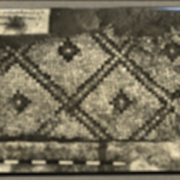For the First Time, Archeologists Restore Flooring from Second Temple Courtyard in Jerusalem
PRESS RELEASE
For the First Time, Archeologists Restore Flooring from Second Temple Courtyard in Jerusalem
Tiles uncovered during sifting of earth originating on Temple Mount
JERUSALEM, September 6th, 2016 — Archeologists from the Jerusalem-based Temple Mount Sifting Project are confident that they have successfully restored a unique architectural element of the Second Temple. Namely, a series of regally decorated floor tiles that adorned the porticos atop the Temple Mount, and which likely featured prominently in the courtyards of the Second Temple during the period that King Herod ruled (37 to 4 BCE) in Jerusalem.
“It enables us to get an idea of the Temple’s incredible splendor,” stated Dr. Gabriel Barkay, co-founder and director of the Temple Mount Sifting Project. The restored tiles will be presented to the general public on September 8th, at the 17th Annual City of David Archaeological Conference. “This represents the first time that archeologists have been able to successfully restore an element from the Herodian Second Temple complex,” stated Zachi Dvira, co-founder and director of the Temple Mount Sifting Project.
The Temple Mount Sifting Project was established in response to the illegal removal of tons of antiquities-rich earth from the Temple Mount by the Islamic Waqf in 1999. It is located in the Tzurim Valley National Park, and is supported by the City of David Foundation and the Israel Archaeology Foundation. The initiative is run under the auspices of Bar-Ilan University and the Israel Parks & Nature Authority.
Frankie Snyder, a member of the Temple Mount Sifting Project’s team of researchers and an expert in the study of ancient Herodian style flooring, succeeded in restoring the ornate tile patterns “using geometric principles, and through similarities found in tile design used by Herod at other sites,” said Snyder, who has an academic background in mathematics and Judaic Studies. “This type of flooring, called ‘opus sectile,’ Latin for ‘cut work,’ is very expensive and was considered to be far more prestigious than mosaic tiled floors.”
“So far, we have succeeded in restoring seven potential designs of the majestic flooring that decorated the buildings of the Temple Mount,” said Snyder, explaining that there were no opus sectile floors in Israel prior to the time of King Herod. “The tile segments were perfectly inlaid such that one could not even insert a sharp blade between them.”
To date, approximately 600 colored stone floor tile segments have been uncovered, with more than 100 of them definitively dated to the Herodian Second Temple period. This style of flooring is consistent with those found in Herod’s palaces at Masada, Herodian, and Jericho among others, as well as in majestic palaces and villas in Italy, also attributed to the time of Herod. The tile segments, mostly imported from Asia Minor, Greece, Tunisia and Egypt, were created from polished multicolored stones cut in a variety of geometric shapes. A key characteristic of the Herodian tiles is their size, which corresponds to the Roman foot, approximately 29.6 cm.
The possibility that large expanses of the Temple Mount during the Second Temple were covered with opus sectile flooring was first raised by archaeologist Assaf Avraham in 2007, director of the Jerusalem Walls National Park with the Israel Nature and Parks Authority.
Avraham’s theory was based on a description given by the Romano-Jewish historian Josephus (1st Century CE) who wrote, “… the uncovered [Temple Mount courtyard] was completely paved with stones of various types and colors…” (The Jewish War 5:2) Additionally, Talmudic literature records the magnificent construction of the Temple Mount, describing rows of marble in different colors – green, blue and white.
“Now, as a result of Frankie Snyder’s mathematical skills, we have succeeded in recreating the actual tile patterns. This represents the first time that we can see with our own eyes the splendor of the flooring that decorated the Second Temple and its annexes 2,000 years ago,” stated Dr. Gabriel Barkay, co-founder and director of the Temple Mount Sifting Project. “Referring to the Temple that Herod built, the Talmud says that ‘Whoever has not seen Herod’s building has not seen a beautiful building in his life’. Though we have not merited seeing the Temple in its glory, with the discovery and restoration of these unique floor tiles, we are now able to have a deeper understanding and appreciation for the Second Temple, even through this one distinctive characteristic.”
Since the Temple Mount Sifting Project’s inception in 2004, more than 200,000 volunteers from around the world have taken part in the sifting, representing an unprecedented phenomenon in the realm of archaeological research.
For more information:
Ze’ev Orenstein – Director of International Affairs, City of David Foundation
Photo Credit: Temple Mount Sifting Project












The photo folder is empty :-(
Reblogged this on Kattukse Vrienden voor Israël.
In an ironic sense, if not for the palis illegal destruction of the Second Temple, much of what we are learning through the sifting, would not be visible. Of course the findings are not in context, but at least we have them now.